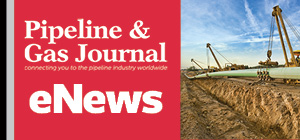Permian Pipeline Constraints Push Waha Gas Prices Below Zero
(Reuters) — U.S. natural gas prices for Monday in the Permian shale basin in West Texas turned negative as spring pipeline maintenance and other constraints trap gas in the nation's biggest oil-producing basin.
Financial firm LSEG said average gas output in the Lower 48 U.S. states fell to 103.9 billion cubic feet per day (Bcf/d) so far in May, down from a monthly record of 105.8 Bcf/d in April.
Part of the reason for that output reduction was spring maintenance on some gas pipes, including U.S. energy firm Kinder Morgan's KMI.N 2.7-Bcf/d Permian Highway from the Permian basin in West Texas to the Texas Gulf Coast.
Kinder Morgan said it will perform a turbine exchange at the Big Lake compressor station from May 13-26 that will reduce mainline capacity to around 2.2 Bcf/d.
Traders have noted the Permian Highway reduction trapped some gas in the Permian basin, helping spot gas prices at the Waha Hub fall by over 260% from 94 cents per million British thermal units (MMBtu) for Friday to a six-month low of minus $1.52 for Monday.
That was the fourth time Waha prices averaged below zero in 2025 and compares with an average of $1.96 per MMBtu in 2025, 77 cents in 2024 and an average of $2.91 over the prior five years (2019-2023).
Waha prices first averaged below zero in 2019. It happened 17 times in 2019, six times in 2020, once in 2023 and a record 49 times in 2024.
Analysts have said negative prices were a sign the Permian region needs more gas pipes.
There are some pipes under construction, including Kinder Morgan's Gulf Coast Express expansion, the WPC joint venture's Blackcomb and Energy Transfer's Hugh Brinson, but they are not expected to enter service until 2026.
The Permian in West Texas and eastern New Mexico is the nation's biggest and fastest-growing oil-producing shale basin.
A lot of gas also comes out of the ground with that oil.
Even though U.S. crude futures were down about 13% so far in 2025, energy firms have been willing to take some losses on gas because they can still make up for those losses with profits in selling oil.
But with oil prices on track to decline for a third year in a row in 2025, some energy firms said they plan to reduce the amount of capital they will spend on new oil drilling this year.
Related News
Related News

- Kinder Morgan Proposes 290-Mile Gas Pipeline Expansion Spanning Three States
- Enbridge Plans 86-Mile Pipeline Expansion, Bringing 850 Workers to Northern B.C.
- Intensity, Rainbow Energy to Build 344-Mile Gas Pipeline Across North Dakota
- Tallgrass to Build New Permian-to-Rockies Pipeline, Targets 2028 Startup with 2.4 Bcf Capacity
- TC Energy Approves $900 Million Northwoods Pipeline Expansion for U.S. Midwest
- A Systematic Approach To Ensuring Pipeline Integrity
- U.S. Pipeline Expansion to Add 99 Bcf/d, Mostly for LNG Export, Report Finds
- Enbridge Adds Turboexpanders at Pipeline Sites to Power Data Centers in Canada, Pennsylvania
- Great Basin Gas Expansion Draws Strong Shipper Demand in Northern Nevada
- Cheniere Seeks FERC Approval to Expand Sabine Pass LNG Facility





Comments